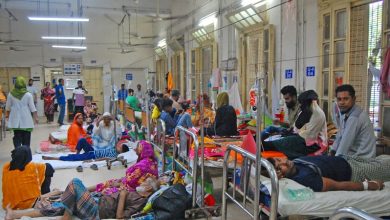Is the energy demand forecast for 2021-41 based on the wrong premise?

The Perspective Plan 2021-41 was approved when Bangladesh’s economy was on a high growth track before the Covid-19 struck the world. As the strategic plan was put to effect, the pandemic had already started raging around the world upending all accounts of economy and life all over.
But the Perspective Plan stood firm with all its projections unchanged. And the new energy master plan was taken calculating the future energy needs based on the Perspective Plan’s forecast of GDP growth of 9.9% by 2041, the terminal year.
Based on the prospective energy need, the Integrated Energy and Power Master Plan, already dubbed “overly ambitious” by a think tank a year ago, projects energy demand to cross 50,000MW in 2041.
After the draft energy master plan was submitted to the energy ministry in June last year, a leading think-tank, Centre for Policy Dialogue (CPD) found its projections unrealistic. It noted that such a projection will shift the country’s energy focus from renewables to fossil-fuels and will ultimately create a worsening fiscal burden from “idle generation capacity”.
These concerns, however, have not been considered by the government as the master plan, IEPMP2023, has already been approved and published on the official website of the energy ministry.
Projection mismatch?
A look into the plan reveals Bangladesh’s future energy generation is going to be locked in import-based fossil fuel as the new master plan keeps gas and coal as the leading primary energy sources in the total energy mix for electricity generation capacity for 2041.
In order to meet the less carbon producing power generation, it has picked up hydrogen and ammonia as renewable technology, neglecting solar energy.
Considering a GDP growth of 8.6% in 2040, an in-between rate of Mujib Perspective Plan 2041 (9.8%) and IMF World Economic Outlook projection (5.4) of GDP growth, the new plan predicted an electricity generation capacity of 74,300MW against an estimated demand of 50,364MW by 2041.
To reach the target, IEPMP2023 also estimated an investment of $157 billion in the power sector.
Experts disappointed
Energy and economics experts, however, said the IEPMP2023 has disappointed them as it would discourage the growth of renewable energy in the future.
Continuing gas and coal as the major sources of primary energy for power generation will increase the cost burden, said Khondaker Golam Moazzem, research director at the Centre for Policy Dialogue (CPD), a local think tank.
Similar concerns were aired by the think tank one year ago.
In an analysis of the interim plan in December last year, the CPD said the new energy master plan has considered the Perspective Plan as the main case for GDP projection for 2041 and 2050. The CPD study found the GDP projection based on PP2041 highly ambitious in the current context. “Hence, the estimated power demand of 90GW by 2050 seems difficult to attain. Considering such a high target of power demand makes the renewable energy-based power generation target (40% by 2041) unrealistic,” the think-tank said.
The new plan still lacks room for the renewable energy-based power generation while continuing to depend on fossil fuels, a major source of energy in the coming decade, it said, adding that a rational demand projection for power and a target to achieve 40% of that projection from renewable energy will be reasonable.
The draft plan does not adequately consider the fiscal burden as capacity payments due to fossil fuel-based power generation and excess reserve margin remain, it said.
The energy master plan also promotes ammonia and green hydrogen, which are yet to be tested and require a hefty investment, the CPD viewed.
CPD Research Director Dr Khondaker Golam Moazzem had pointed out “a substantial mismatch” between the demand and supply in the power and energy sector, as the excess reserve capacity in November 2022 was as high as 60% against the total installed capacity of 22,608MW.
Due to keeping excessive capacity idle in the system, the Bangladesh Power Development Board (BPDB) incurs huge annual losses, which are covered by subsidies, amounting to Tk11,777 crore alone in FY21, he mentioned.
Despite that, the demand projection still promotes a high reserve margin of 30% in 2030 and 25% in 2040, said Moazzem.
The plan marks a shift from the government’s earlier target of generating 40% electricity from renewable energy by 2041 as committed during the COP26 conference, and rather envisages 40% of “clean energy” that also includes coal and other hydrocarbon-based energy mixes, he said.
A year later, the economist expressed his disappointment as the new plan had already been approved without responding to the concerns.
“The target set in the new plan is very frustrating. The policy support that was required against the gradually increasing foreign investment in renewable, has not been reflected in the IEPMP2023,” he said recently.
“Unfortunately, we can see the promotion of some technology from countries that were involved in preparing this document. Instead of our country, this master plan will benefit those countries,” he added.
LNG to rule power generation
In the previous power sector master plan (PSMP 2016), it was projected that gas would account for 35% of the total electricity generation in 2041.
This cheapest option of power generation nowadays has become costlier as the authorities have to import LNG to feed the power plants amid the depleted production from the local gas fields.
In this backdrop, when the preparation began to place an integrated energy and power master plan in 2021, experts were expecting that the new plan would decrease the dependency on the imported fossil fuel to reduce the forex payment.
But the IEPMP2023 projection did not see a curtailment of the share of gas as it estimated that this energy will hold a share of 40% or more up to 2041.
Commenting on the IEPMP2023’s projection, Shafiqul Alam, lead energy analyst at the Institute for Energy Economics and Financial Analysis, said, “This will lock us in imported fossil fuel dependence. Instead, we need to be cautious about fossil fuel-based over-capacity and should take advantage of cheap renewable energy. The BPDB should be engaged in the implementation of renewable energy projects.”
Of the country’s total daily gas supply, 80% is being produced in the local fields.
But gas production is projected to decrease from the present 2,100mmcfd to 1,700mmcfd in 2041, even if the production is jacked up with workover on the existing wells and drilling of appraisal and development wells on the existing gas fields.
In order to meet the newly projected daily 4,000mmcf demand in 2041, though the previous projection was over 6,000mmcf, LNG import would have to increase from 5 million tonnes per year to 16, the new plan projects.
To accommodate the increasing requirement for LNG import, the country will need to introduce additional LNG receiving terminals, says the new plan.
At present, the country has two LNG terminals with a capacity to inject 1,100mmcf gas per day after regasifying imported LNG.
Shift from renewables?
At present, renewable energy sources that include solar, hydro and wind, account for 4% in the total 25,951MW electricity generation capacity.
As per PSMP2016, it was expected to be 10% by 2030, though the prime minister made a commitment to achieve 40% electricity from renewable sources.
But the IEPMP2023 distorted the renewable targets by introducing a new term, “clean energy” that takes the form of new technologies, most of which are unproven and expensive, said M Zakir Hossain Khan, Chief Executive at Change Initiative, a renewable energy research and advocacy organisation.
The CPD study of the plan said shifting from 40% renewables to up to 40% from cleaner energy “confuses and weakens” the commitment for renewable energy.
Under clean energy, the new master plan set a target to achieve 6% of electricity from hydrogen and 2% from ammonia by 2041 while 10% projected from wind and 6% from nuclear.
“This estimate contradicts the target of the NDCs to the Paris Agreement on climate change, Mujib Climate Prosperity Plan, Renewable Energy Policy and most importantly the commitment of the Prime Minister to supply 40% of electricity from renewable sources by 2041,” said M Zakir Hossain Khan.
He was concerned that this IEPEMP would discourage the national and international flow of investment to renewable energy that gets momentum in 2022.
In the previous plan, the share of coal in power generation was estimated to be 35% by 2041. But the latest integrated plan proposed a share of coal, as low as 15%, for power generation.
Though the share of coal in the energy mix goes down, the consumption of this dirty fuel will continue to increase during the 2030s as three large plants – Rampal, Banshkhali and Matarbari – have entered into production recently.
Until 2020, coal consumption for power generation was only 1 million tonnes per annum. But the consumption is going to increase to 12 million tonnes within next year if the completed plants run at full capacity and coal consumption could cross 30 million tonnes if all 15 projects come in operation.
IEPMP2023, however, predicts that the coal consumption for power will begin to decrease in the early 2040s as coal will gradually move to ammonia-cofiring to control GHG emissions.
Estimated Investment
The required investment amount of these generation capacity installations is estimated at $157 billion in total.
The investment for natural gas-fired power generation (including those with CCS) is the largest (49%) followed by wind (19%), and nuclear (13%).
Additional investment will not be an urgent issue even though its power demand will keep growing as the country currently has a surplus generation capacity, says the Master Plan.
However, in the later stage, such surplus capacity will shrink, and investments will need to be accelerated in accordance with the demand growth.
Apart from power, the natural gas and LNG sector would require $1,532 million by 2041, estimated the IEPMP2023.
Research organisations and experts have long stressed that the energy strategic plan should emphasise more on gas exploration and aggressively look for investment in renewable energy.
Fossil fuel-based power plants in retirement should not be extended further under the Quick Enhancement of Electricity and Energy Supply (Special Provision) Act 2010 and the existing IPP contracts should also be reviewed, the CPD said, hoping that this will save resources in terms of capacity payment and subsidy. Additionally, it will save the foreign exchanges required for importing fuels.





